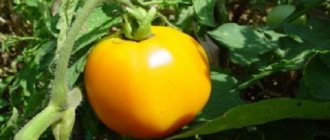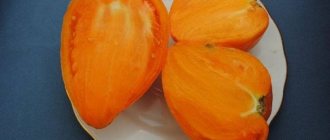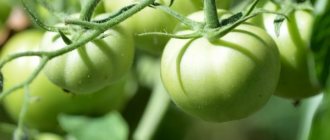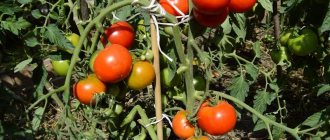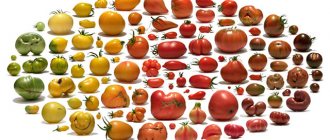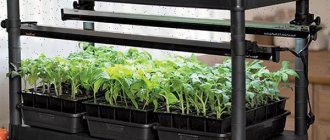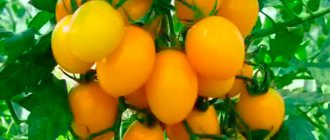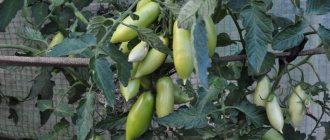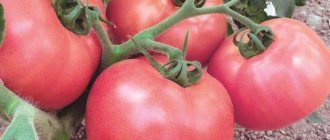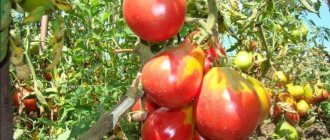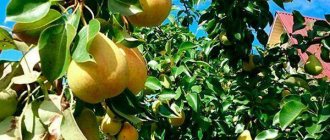Unusual yield of gold on the plot - who among the farmers does not dream of this? The Golden Brush tomato is, in addition, incredibly tasty and absolutely unpretentious.
| Height | Landing location | Ripening time | Fruit color | Fruit size | Origin | Fruit shape |
| Tall | Greenhouse, Open ground | Early ripening | Yellow | Small | Variety | Pear-shaped |
Tomato Summer resident - a variety for busy gardeners
The Summer Resident tomato did not get its name by chance. After all, summer residents, although very enthusiastic people, are mostly busy with their main jobs and cannot visit their gardens every day. This tomato does not require constant participation in its destiny; it easily forgives the absence of the owner on the site.
Description of the Dachnik variety, its characteristics, growing region
The Summer Resident tomato is not young: it was registered in the State Register of the Russian Federation in 1999. The variety was obtained by specialists from the All-Russian Research Institute of Vegetable Growing; the originator was, among other things, the seed industry. At that time, there was no such wave of new varieties and hybrids, and each new product could be tracked by amateur gardeners. The summer resident turned out to be a lifesaver for many enthusiasts, although it is officially approved for cultivation only in the North Caucasus region, of course, in open ground. Yes, it is not profitable to plant this tomato in a greenhouse: its bush is not tall, and a lot of free space will be wasted. But in those regions where tomatoes can grow without greenhouses, gardeners began to plant this variety with pleasure.
Infographics: a brief description of the Dachnik tomato variety according to the State Register
Brief description of the tomato variety Dachnik according to the State Register
The Dachnik variety is a representative of determinate tomatoes; its bushes rarely exceed the half-meter mark in height and practically do not require the formation or even tying of shoots. The bush is semi-spreading in shape, branching and foliage are at an average level. Leaves are of normal size and color. 4–5 fruits are formed in the cluster.
The summer resident’s bushes are small, but covered with fruits
In terms of ripening time, the variety is classified as an early ripening variety; the first fruits ripen approximately 100 days after germination. In the south, it is sometimes even considered ultra-early, although now there are many varieties that ripen a week or two earlier than Dachnik. The first wave of the harvest, lasting one and a half to two weeks, is the main one, then fruiting continues little by little until frost.
The fruits are medium-sized, round or flat-round in shape, scarlet or red in color, containing at least four seed nests. The weight is in the range of 50–100 g: tomatoes cannot be called leveled. The taste of fresh fruits is characterized as good, with a pronounced “tomato” aroma. The skin is thin, the pulp is medium dense. The main purpose is salad, but the size of the fruit allows them to be preserved as a whole.
Since at the time of its appearance the variety was recommended for commercial production, that is, for large agricultural enterprises, its tests were carried out not in small gardens, but in field conditions, where it showed good yield. In official documents it is given in terms of per hectare. On average, the variety produces from 250 to 350 c/ha, which is at the level of standard commercial varieties. In the open ground, summer residents, with not very careful care, can harvest up to 4 kg of tomatoes per square meter. The possibility of industrial cultivation is based, among other things, on the good transportability of the crop. Fresh tomatoes can be stored for up to three weeks.
The variety is highly resistant to diseases, including fusarium and blossom end rot. Despite its regionalization in the south, it has good cold resistance. Since the bushes of this tomato are quite compact and stocky, it is often planted indoors, as well as on the balcony.
Video: full characteristics of the Dachnik variety
Appearance
In appearance, the fruits of the Dachnik tomato do not differ from many other varieties: they have the most traditional color (red), the most common shape (almost spherical), and the size is slightly smaller than average. The fruits are distinguished by their correct shape and the absence of defects in the form of any tubercles, depressions, cracks, or color distortion. These are the kind of tomatoes that people say “just like in a picture.”
The Summer Resident’s fruits are not outstanding: the most ordinary-looking tomatoes
Advantages and disadvantages, features, differences from other varieties
Like many other early-ripening, unpretentious tomatoes, Dachnik cannot boast of an exquisite taste. Something else is required of him: early and without much hassle, provide the owner with a good harvest of vitamin products. The main advantages of the variety are:
- early ripeness;
- simplicity of agricultural technology;
- stable yield;
- transportability of the crop;
- versatility of use;
- excellent fruit set, including in unfavorable conditions;
- Possibility of growing on the balcony.
Among the disadvantages is not the best taste of the fruit, the possibility of late blight. In addition, despite the determinacy, it is still advisable to tie up the bushes, although not all summer residents do this: under the weight of the harvest, they can lie on the ground, and the tomatoes simply get dirty or become prey for slugs.
Since the word “summer resident” is quite common, it is also found in the names of other varieties and hybrids of tomatoes, so do not confuse Summer Resident with the tomatoes Ural Summer Resident, Summer Resident of Kuban, as well as with the hybrid Summer Resident F1, the seeds of which are sold by the agricultural company Aelita: this hybrid produces a huge amount stepsons and needs to form a bush.
There are many analogues of the Dachnik variety, including among old varieties. It is quite similar to the famous Alpha and Betta tomatoes, but ripens a little later. The advantage of these varieties, compared to Dachanik, is the absence of regional restrictions, but they are not recommended for commercial production. Of course, many new varieties and hybrids have appeared that will most likely displace Dachnik from its “legitimate” niche, but for now it is still in operation.
Tomato Alpha is similar to Dachanik in many respects, but ripens earlier
Features of planting and growing tomatoes Summer resident
The Summer Resident tomato can be grown without preparing seedlings, especially in the recommended North Caucasus region. Seeds sown directly into the garden bed with the onset of warm weather or under temporary shelter will sprout perfectly, and after the required 3.5 months it will be possible to harvest ripe tomatoes. But in regions that are not the warmest, this approach will allow you to harvest only in August, when you no longer really want tomatoes that don’t have the most exquisite taste. Therefore, in most areas, Dacha is grown through the seedling stage.
Seedlings of this tomato are easy to obtain; you should not sow the seeds too early. After all, seedlings can be planted in a garden bed only at the onset of summer, but for a summer resident they are ready for planting already at the age of one and a half months. By two months the bushes are already beginning to bloom. But the small growth of tomatoes makes it easier to install temporary shelters, which is often used to obtain an earlier harvest. Under this condition, in the middle zone, planting seedlings is possible as early as May 10–15, which means that seeds can be sown in boxes in mid-March.
How to grow?
Seeds are planted 60-65 days before the seedlings are finally placed in open space. As a rule, this is done in March. Planting material purchased in a store does not need additional processing, but if the seeds are obtained independently, they need to be prepared:
- To select high-quality material, use a saline solution (add one teaspoon to a glass of water). Seeds are placed there, and those that float are thrown away.
- Before planting, disinfection is carried out, because Most pathogens live on the surface. Seeds are disinfected with a 1% solution of potassium permanganate for 20 minutes. A 2-3% peroxide solution heated to 45 degrees is also suitable for this.
- To improve the quality of the variety and germination, planting material is soaked in a solution of Epin or Immunofitsit, which contains many nutrients.
Having done all of the above, you can start sowing. Additional germination is used as desired. It helps to reject low-quality seeds and accelerate the development of seedlings.
For germination, use a damp cloth or cotton material. The seeds are placed on a cloth, covered with film, placed in a warm room and kept at a temperature of 20-25 degrees for several days until the sprouts hatch.
Seeds purchased in a store (sprouted or dry) are placed in peat soil at a distance of 1 cm from each other. They are sprinkled with a thin layer of peat on top. Then watering is done through a sprayer or strainer. A direct, high-pressure jet will not work here; the planting material may float. The container with seeds is placed in a lighted area with a temperature of up to +25 and covered with film. When sprouts form, they are opened so that they can be hardened and absorb dry air normally.
After the formation of 1-3 true leaves, the seedlings are picked into glasses or pots, with a slight depth. To avoid stretching of plants, 12-hour lighting is used. When there are 5 or 6 leaves, the tomatoes are ready to be planted in open ground or a greenhouse. At the permanent place of growth, the sprouts are distributed in 4 pieces per 1 square meter. m. If the soil moisture is high, tomatoes can rot, so the soil needs to be loosened regularly.
As tomatoes grow, they are tied to a high support and pinched at the top of the head so that they stop stretching. If the bush is formed into 2-4 stems, the incorrectly developing stepsons need to be cut off. This is done in the morning so that the broken areas dry out. To prevent the plant from getting sick, such areas are sprinkled with coal or smeared with brilliant green.
When the soil surface dries out at a depth of 4-5 cm, watering is necessary. For this, a special sprayer or drip method is used, which simplifies the procedure. The soil is moistened with water of average temperature, approximately +16.
Particular attention should be paid to gartering bushes
It must be done very carefully so as not to deform the plant. The procedure is necessary until the tomato stops growing
The easiest way is to tie it to a stretched wire. This is done like this:
The procedure is necessary until the tomato stops growing. The easiest way is to tie it to a stretched wire. This is done like this:
- Several sticks are placed on the ridge, and a wire is pulled over them. The bushes are tall, so a three-level garter is needed.
- The plant is secured with tape or thick thread; thin thread will not work. She can just cut the tomato.
- The stem is tied in accordance with the growth of the crop: 1st time at a level of 25 cm from the ground, 2nd at 1 m. It is necessary to support not only the stem, but also the brushes, which can break off under the mass of fruit. They are tied in the center and spread to the sides, creating the so-called “tomato wall”.
The already mentioned formation of the bush is carried out according to the following rules:
- stepsons, the length of which reaches 4-5 cm, break off at a distance of 1 cm from the stem;
- formation occurs on the side shoot;
- You need to plant the stepson in warm weather and no wind;
- bushes are processed only with gloves, and immediately after each procedure, hands are washed with potassium permanganate to avoid infection
Description of the tomato variety Golden Brush, features of cultivation and care
This tomato variety has won the hearts of gardeners with its golden color of fruit. The Golden Brush tomato appeared on the market recently. In 2015, it was added to the register of plants for growing in dachas and gardens in open areas and under film. But in such a short period of time, I have already received positive reviews from satisfied gardeners for the excellent qualities of the tomato.
Distinctive features of tomato
High productivity is its main characteristic. Up to 6.5 kilograms of fruit are harvested from one square. Early ripening - the first ripened vegetables appear on the bush 80 days after planting.
The plants are decorative thanks to the beautiful golden-yellow clusters of pear-shaped tomatoes.
Description of tomato
The bush is of an indeterminate type, tall - reaches a length of 1.5 meters when grown outdoors and 1.8 meters in film shelters. The bushes are tied to a support or crossbar for stability. Plants of medium foliage with cluster formation of fruits. Up to 20 drop-shaped fruits are formed on one bunch. Productivity produced in a greenhouse is several times higher than in open areas.
The fruits are yellow in color, have a white core and 2 seed nests. The weight of one tomato is 20–30 grams. The taste is sweet, the flesh is loose, not juicy.
Used mainly for fresh consumption, they look great as a decoration for the dining table. Canning is also possible, but due to the loose consistency of the pulp, it is rarely used. Despite their small size, they tolerate transportation well.
How to grow a tomato correctly?
This variety is grown by seedlings; the seeds are planted in March-April, depending on the place of cultivation. Before planting tomatoes in a permanent place of growth, you need to do the following work:
- Plant seeds for seedlings.
- Dive it into separate pots.
- Fertilize several times.
- Replant into the ground.
The time frame for planting seeds, transplanting seedlings and planting them in the ground in different climatic zones is different, but one thing remains the same. Transplanting seedlings into the ground at the main place of growth should be done at a stable daytime air temperature of 22 degrees. The night temperature should not fall below 16 degrees. Tomato seedlings are planted 2 months before transplanting into the ground. Therefore, every lover of fresh tomatoes calculates the planting time independently based on the above features.
Caring for tomato plants
After planting the plants in the ground, they are cared for:
- weeding;
- watering;
- garter;
- stepsoning;
- loosening the beds;
- feeding
If these manipulations are carried out, a bountiful and healthy harvest is harvested from the bush. Considering that the description of the variety says that the fruits ripen almost simultaneously, you can pick tomatoes several times in large quantities.
Review of reviews about the variety
The variety appeared recently, but already has positive reviews about its qualities:
- Irina Mikhailovna writes: last year I planted this variety. Ripens in an open area like a regular medium variety. I like the brushes with tomatoes. They are shaped like a pear or a drop, as you like. They’re delicious, but I won’t pickle them anymore because they fall apart in jars. But maybe I just didn't do it right. Otherwise I liked everything, they are easy to care for.
- Maxim Viktorovich: I like to experiment with tomatoes, I have already tried many varieties. I also liked this tomato; I grew it in a greenhouse, tied it to a crossbar, and formed it into two bushes. The harvest was abundant, the tomatoes were all one, beautiful and tasty. I recommend it for growing in greenhouses.
Feeding seedlings
Seeds are sown in special wooden boxes, marked rows of 5 cm, respectively, no deeper than one centimeter in depth. Provide irregular soil heating up to 25 degrees Celsius. From sowing to the appearance of seedlings, it takes up to 10-12 days, until two to three leaves appear - again, about 14 days.
The lack of natural light is compensated for by fluorescent lamps and ultraviolet lamps. Plants are good. Ant. You can’t dive into separate peat pots. The room temperature is reduced from now on to 18-20 degrees so that the stem does not stretch. The seedlings grow within 50-55 days, throwing out leaves. After the formation of more than 5 leaves, the seedlings must be hardened, lowering the air temperature to 15-17 degrees, and arrange through ventilation of the room.
Hardened plants can be planted in the ground. Tomatoes that are grown in seedlings in film greenhouses do not need additional hardening.
When growing tomato bushes in film greenhouses, it is inevitable to monitor the heating of the air and soil. It is not forced to exceed 35 - 37 degrees in the warmest time. At high temperatures, the bush begins to grow, throws out many additional shoots and leaves into the air (avoiding air conditioning. If the greenhouse or hotbed is overheated, ventilation, access to fresh air and mandatory evening drip irrigation of the plants should be arranged. If properly cared for, the yield in greenhouses is slightly higher than open ground.Shrubs in open space grow earlier than 1.5 - 1.6 meters, in closed greenhouses they reach up to 1.8 - 2.0 meters.
Summer resident tomatoes: variety yield and reviews of those who planted
Reading time: 8 minutes
Summer resident tomatoes are an unpretentious vegetable crop with minimal requirements. This versatile variety is perfect for beginner gardeners without experience in this matter. However, any crop requires high-quality care and attention - only in this way can a healthy and abundant harvest be achieved. Therefore, it is recommended that you familiarize yourself with the characteristics and description of the Dachnik tomato variety. It is worth noting that it can be grown even at home: on a balcony or loggia.
Selection and description of the Dachnik variety
The Dachnik tomato is a product of Russian selection, which was obtained under the leadership of Gorshkova N.S. and registered in the State Register back in 1999. Today, seed material of this variety is offered by a large number of producers, but initially it was the originator. The summer resident can boast of unpretentiousness, resistance to diseases and a large number of ovaries in all weather conditions. The purpose of the variety is universal.
The tomato bush of the Dachnik variety is of a determinate type, and therefore does not require pinching. The plant can reach a height of 80 cm. As a rule, a bush of this size is tied up. Tomatoes are characterized by medium branching and have a small number of leaves. The maximum yield can be obtained if you grow a bush with four stems. The seedlings of this variety are strong and rather stocky. Up to 10 tomatoes are tied in one brush.
Fruits and yield of tomato
The Dachnik variety is an early ripening tomato, and its fruiting is long-lasting – the bush bears fruit until September. The first harvest can be harvested 90 days after the first shoots appear, but the ripening period varies from 95 to 110 days. A gardener can get up to 3 kg of tomatoes from one bush, and with quality care this figure increases to 4 kg. Tomatoes are flat-round, without ribbing. The pulp is pink-red, juicy, with thin skin. The average weight of one fruit is 70 g. There is a pronounced tomato smell and slight sourness. The variety is recommended for commercial production.
Comparative characteristics
The low taste qualities of the fruit are compensated by the unpretentiousness, ease of cultivation and rapid ripening of tomato products. The Dachnik tomato variety stands out from other tomatoes, which are characterized by early ripening:
- while the weight of fruits in Dachnik is 60-100 g, in Premier - 120-180 g, in Kostroma - 90-145 g;
- due to their compact size, Dachnik tomatoes can be grown on the balcony, which is not possible for other varieties;
- many varieties of tomatoes do not tolerate cold weather - the Summer Resident, in turn, demonstrates a large number of ovaries under any conditions;
- The yield of Summer Resident is 4 kg per bush, for Gulliver - 7 kg, for Rocket - 6 kg, for Pink Lady - 25 kg.
- The characteristics of the variety are similar to Alpha and Beta tomatoes, but they have no restrictions on growing areas.
There are a large number of varieties that can compete with Dachnik tomatoes. However, these tomatoes have their own positive qualities that help him “keep in line.”
In what regions can it be grown?
The Dachnik tomato is intended for cultivation in most regions of Russia, excluding the northern regions. Officially, tomatoes are zoned for cultivation mainly in the North Caucasus region, but they are grown almost everywhere. It should be added that tomatoes are intended for planting in open ground, since it is unprofitable to grow them in a greenhouse.
Planting and care
Tomatoes of the Dachnik variety can be grown in two ways: by pre-planting seedlings or by sowing directly into open ground with the onset of warm weather. Under shelter, tomatoes will sprout well and after 3.5 months the first harvest can be harvested. However, in cold regions, with this approach, the harvest will appear only in August. In this regard, in most cases, Summer Residents are grown by seedlings. Further care includes basic agrotechnical measures. Moderately heavy fertile soil is suitable for tomatoes.
Terms and rules for sowing seeds
You should not plant seeds for seedlings too early, since the Dachnik variety is prone to a rapid transition to the flowering phase. Therefore, seeds should be sown at the end of March, since by two months the bushes already begin to flower. Provided there is shelter, seedlings can be planted in the middle zone in early May, so seeds are sown in mid-March or early April. To grow seedlings you will not need special pots: it will be enough to grow the seeds in a common box.
Tomato Golden Brush
photo author Mira Tom
Description of the tomato variety Golden Brush, reviews, photos
An early-ripening, tall variety of cherry tomatoes. Forms smooth and very beautiful brushes. In the middle zone, it is recommended to grow it in a greenhouse. The period from germination to the beginning of ripening is 95-98 days.
Bush of indeterminate type, up to 2 meters high. Requires tying to the support and pinning. The best results were obtained when forming a plant with 3 stems. The leaf of this tomato is medium, green in color. The inflorescence is simple.
